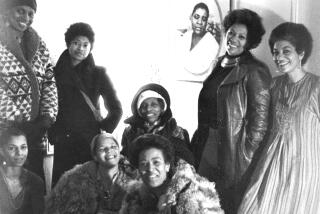Review: Lina Meruane’s ‘Seeing Red’ is a piercing novel of blindness
- Share via
In the second half of Lina Meruane’s astonishing novel “Seeing Red,” the protagonist, Lina, lies in the operating room awaiting eye surgery to treat blindness caused by diabetic retinopathy. We read: “What is left of her now is pure biology: a heart that beats and beats, a lung that inflates, an anesthetized brain incapable of dreaming, while the hair goes on growing, slowly, beneath the cap.” The biological permeates “Seeing Red,” as if Lina, her vision obscured by the bleeding veins of her retina, is forced to see everything in terms of biological function. Without sight, Lina relies on her “neurons and their bristly dendrites” for guidance. Time itself is “stretched out like arbitrary veins.”
The narrative has its basis in Meruane’s own experience of blindness, and author and protagonist share a name, but the story departs decisively from autobiography. Through the experiences of her double, Meruane probes the possibilities unleashed by crisis.
The novel begins in the moment Lina’s eye becomes clouded with blood: “It was happening. Right then, happening.” A Chilean writer studying in New York, Lina grapples with uncertainties: Will she regain her sight? Will she be able keep writing? And will her partner, Ignacio, remain committed to her? What follows is a riveting exploration of her new condition as she steps into a world of paradoxically heightened perception.
Blindness is like “being asleep and awake at the same time,” and Lina’s movement through the city turns the streets of Manhattan into a cacophonous underworld. Everywhere, she imagines the form of an eye, her fingertips becoming “lidless eyes” that see through touch; she opens a car window “like someone opening an eyelid.”
Meruane’s authorial gaze is unflinching. Through the mesh of veins, she holds a microscope not only to the condition suffered by her alter ego, but to the ties between the protagonist and those on whom she is forced to depend, ties strained by Lina’s history of illness and her loss of sight. Lina resists all attempts to corral her into victimhood and insists on wielding her agency like a weapon. Her manipulations of Ignacio provide a visceral antidote to infantilizing narratives of illness; Lina’s behavior is predatory rather than passive, and “Seeing Red” becomes a searing commentary on the limits of family relationships and the cruelty that, under duress, we are capable of exerting on those we love.
It is also about isolation in the face of trauma. Ignacio clings to Lina in the absence of other family; the narrative hints at his lonely past, but the couple face isolation even in their togetherness. They are “[t]wo strangers brought together by accident in the impossible riddle of illness.” When her family fails her, Lina seeks in Ignacio someone “with a true vocation for sacrifice.” She tests Ignacio’s capacity for self-abnegation, ultimately pushing him toward a terrifying bond that transcends even the ties of consanguinity.
While Meruane magnifies the particular details of her protagonist’s experience, her vision is also expansive, for if a person can be wounded, so can a country. “Seeing Red” takes place between the two poles of Lina’s existence — New York City and the capital of her native Chile. A historical duality forms part of the novel’s backdrop: the two Sept. 11s — the 1973 military coup in Chile and the 2001 terrorist attack in New York — punctuate the distance between the novel’s two locations.
In her blindness, Lina remembers absences she could once perceive with sight, recalling “the hollow left by the twin Manhattan towers.” In Chile, driving by the Moneda Palace, she remembers it as it was before the coup, as well as the bullet holes in a nearby building, and the dark soot that covers them like a blindfold. It is as if these absences were an anticipation of the replacement of sight by memory.
Meruane’s sentences burn with vigor and urgency. Occasionally, they dissolve before concluding, forcing the reader to complete the thought, as if words themselves had been cauterized, like veins: “If the tension rises. If some sharp emotion. Danger sign, and then.” The full force of this rawness comes through in a lucid translation by Megan McDowell, who has also brought us other contemporary Chilean authors: Alejandro Zambra and Arturo Fontaine.
Meruane is not the kind of writer to provide a redemptive ending. In fact, she spurs a desire to reread, in the light of an ending that is another beginning. Her uncompromising vision and piercing prose are reasons to celebrate the long overdue appearance of this bracing voice in English.
Whittle is a New York-based writer and translator and an editor at Cardboard House Press.
Seeing Red
Lina Meruane, translated by Megan McDowell
Deep Vellum: 170 pp., $14.95 paper
More to Read
Sign up for our Book Club newsletter
Get the latest news, events and more from the Los Angeles Times Book Club, and help us get L.A. reading and talking.
You may occasionally receive promotional content from the Los Angeles Times.







